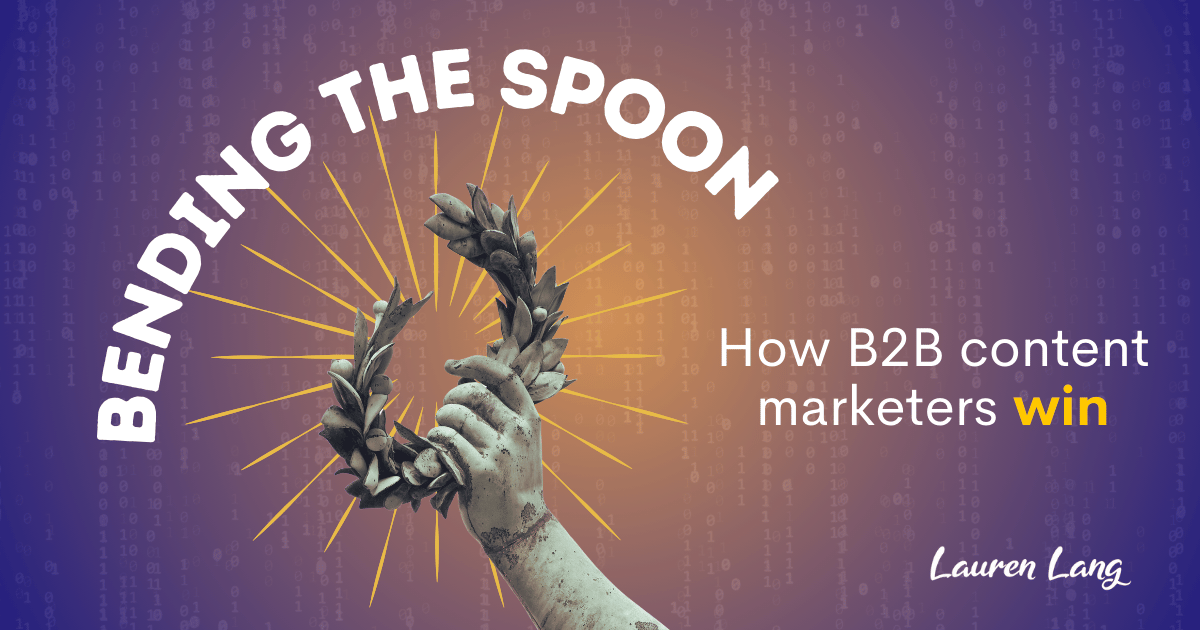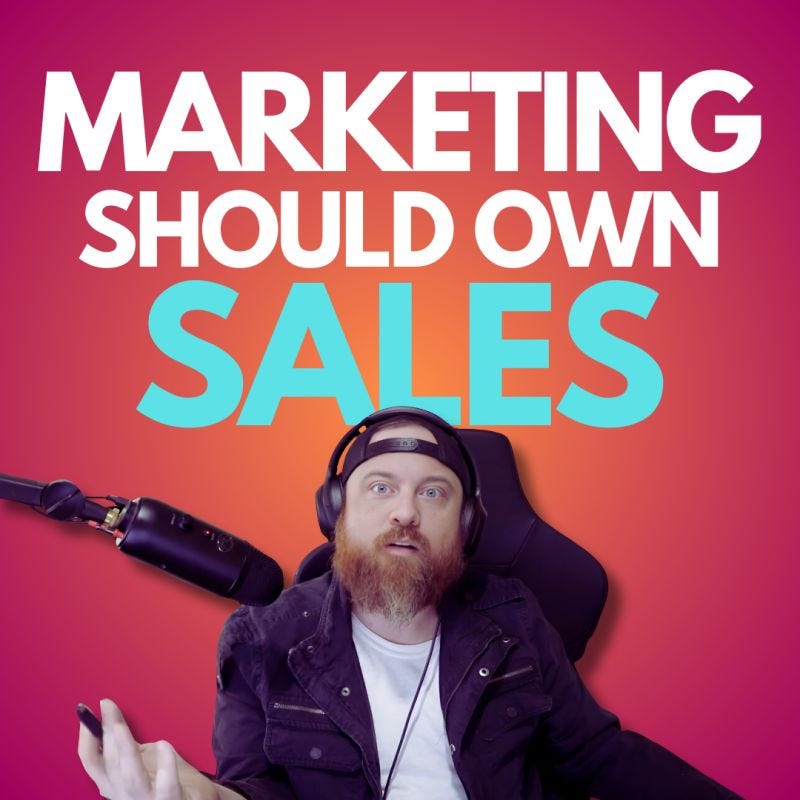Here is a tale of two bottom-of-funnel content pieces from my past, one more recent than the other.
Scenario A (“The darkest timeline”): I publish a PDF with a special UTM link that sales needs to use so that I can track that the content was seen by the prospect. They just download it and send it as an attachment. They might tell me after the fact they did this, but for all intents and purposes any impact that I might have driven is lost to the ages. I sigh and begin the answer I’ve given to sales teams 459 times: YOU NEED TO TRACK IT. HOW WILL WE KNOW IF CONTENT MADE A DIFFERENCE OTHERWISE? Sales doesn’t care because it doesn’t make a difference to them one way or the other. Later, the executive team has doubts that content is making a difference at all.
Scenario B (last week): My CEO says, “Hey, I just sent that one-pager you created directly to the prospect and bypassed the “enter your email” page. We don’t really need to track that, right?” I say, Nah, all good. Whatever is easiest for you and them; the important thing is that they’re able to see it.
It’s amazing how little time goes into nickel-and-diming content’s impact when the value of long-term investment in brand isn’t a question.
Some of this is based on trust: I’ve delivered some very good results for my current company where content brought in some inbound opps, and we’re seeing the flywheel beginning to turn in ways that are unquestionably positive.
But it’s really a question of incentives: what is the motivating force behind the way we work? What are we being held accountable for? Is every day a hostage situation where we’re negotiating our right to exist, or are we able to move beyond that to embrace the creativity and innovation that drives actual impact and results?
This isn’t a single person’s problem. It’s a system. And that’s what we’re going to talk about today.
💪 Actionable tip: map out your incentive ecosystem
Before you can change a system, you need to see it clearly.
Most content marketers are operating inside incentive structures they've never consciously examined, so let's change that.
Start by creating what I call an incentive map for your go-to-market team. This isn't just an academic exercise — it's illuminating in the way discovering your company's salary bands might be. Suddenly, everything makes sense.
Begin with the North Star metrics for each team:
Content Marketing: Organic traffic? MQLs? Conversions? Asset downloads?
Demand Generation: MQLs? SQLs? Demo requests?
Sales: Pipeline generated? Revenue closed?
Customer Success: Retention? NPS? Expansion revenue?
Now ask yourself: Do these metrics actually align with each team's level of authority and influence? If content is measured on MQLs but has no control over which assets are gated — or the entire marketing team is assessed by SQLs but has no say in how SDR follow-up happens — that's a misalignment.
Next, document what gets celebrated in your organization:
Which wins get announced in all-hands meetings? Who’s given credit?
What behaviors get people promoted?
When budgets get cut, what's protected and what's sacrificed?
I once watched a CMO cut the entire brand budget during a downturn while preserving every dollar of paid search. The message was crystal clear: immediate, attributable leads matter; long-term brand equity doesn't.
Finally, examine the approval thresholds for different activities:
Can demand gen run a $50K event without approval while content needs sign-off for a $500 illustration?
Does product marketing get automatic buy-in for new messaging while content struggles to get approval for topic shifts?
Who has to justify their existence in quarterly reviews, and who doesn't?
And let’s be clear: this is not intended to point fingers at other teams or functions. It's about seeing the water you're swimming in. Because once you see it clearly, you can start having meaningful conversations about changing it.
🚫 Antipattern: the Goodhart's Law trap
Once upon a time, a British economist named Charles Goodhart made an observation that would become known as Goodhart's Law: "When a measure becomes a target, it ceases to be a good measure."
Here's how it typically unfolds: You notice that case studies correlate with higher conversion rates. Great! So you make "produce more case studies" a target. Soon, you're cranking out mediocre case studies just to hit your numbers. Your conversion rates plummet because — surprise! — correlation wasn't causation, and quantity ≠ quality.
I've watched content and marketing teams destroy themselves this way. The KPI Death Spiral goes something like this:
Team identifies a metric that seems to indicate success
Metric becomes a target with quotas attached
Team optimizes for the metric at the expense of actual impact
Quality suffers; audience engagement drops
Leadership decides it all "doesn't work"
Budgets get cut; layoffs follow
We do this to ourselves because we're desperate to prove our worth in concrete terms. I've sat in meetings where I've twisted myself into logical pretzels trying to demonstrate how a thought leadership piece directly influenced pipeline.
And we know that the things that matter most in content marketing are often the hardest to measure. Things like brand affinity. Trust. Perception shifts. Resonance.
The solution isn't to abandon metrics altogether — that's a fast track to budget cuts. It's to use metrics as indicators, not targets. To measure what you can while acknowledging what you can't. And to have the courage to fight for content investments that might not show immediate returns but will build the foundation for sustainable growth.
When leadership asks why organic traffic is down 15% this quarter, have the courage to say: "Because we're focusing on depth over breadth. Our goal isn't more eyeballs — it's the right eyeballs. And here's why that matters to our business."
Because if you don't push back on bullshit incentives, you'll forever be chasing metrics that don't matter.
Need help communicating content’s value to executives? Bending the Spoon teaches content marketers to think like leaders by proving the value of their work. I’ll show you how to use data to correlate content to pipeline, how to communicate successfully with executives, and how to build cross-functional relationships that make you an MVP in your organization.
💡 Big idea: burn it all down?
Clark Barron recently lit up LinkedIn with what amounts to a “modest proposal” for B2B marketing. His argument, stripped to its essence, is this: If marketing is expected to own revenue, then marketing should own sales.
His point, more than even the proposal itself, is that our current incentive structure is profoundly broken.
Think about it: Marketing is expected to "own revenue" but has zero control over whether deals actually close. We're judged on pipeline that we can't directly influence. We're first to be blamed when numbers miss, despite having the least authority in the revenue process.
As Clark put it: "Imagine a restaurant where the chef is responsible for the number of customers that come in but has no say in how the waitstaff treats them, what they're served, or whether they even get their damn food."
While I'm not advocating for a marketing coup to overthrow sales (though the mental image is amusing and it would bring the parts of me that are petty GREAT JOY), I do think we need to radically reimagine our incentive structures.
What if:
Content teams were evaluated on engagement depth and customer retention, not just acquisition metrics?
Budget allocations were based on customer lifetime value influenced, not just leads generated?
Companies invested in content the way they invest in product — as a long-term asset, not a quick-hit tactic?
Desperate times call for desperate measures, and I think we’re feeling desperation as an entire industry. Getting to a place where you and I can hold off burnout for longer than the next 3-6 months requires educating leadership about what truly matters in content marketing.
It means pushing back on short-termism and advocating for investment in brand building alongside demand generation.
It means helping them understand that while content's impact can't always be captured in a dashboard of green arrows pointing upward, it's what differentiates great companies from mediocre ones.
Look, I get it. In the current economic climate, suggesting longer-term investments feels risky. But the alternative — continuing to chase metrics that don't matter while neglecting the work that could genuinely transform your business — is far riskier.
Your content strategy is only as good as the incentives that shape it. Let’s all build something better.
What incentive structures have you seen work well (or spectacularly badly) in content marketing? Hit reply — I'm curious to hear your experiences.












